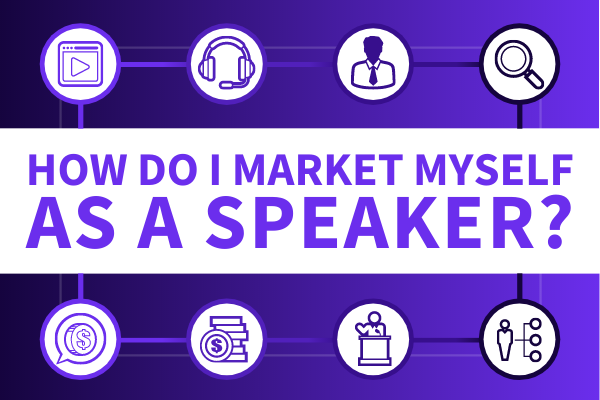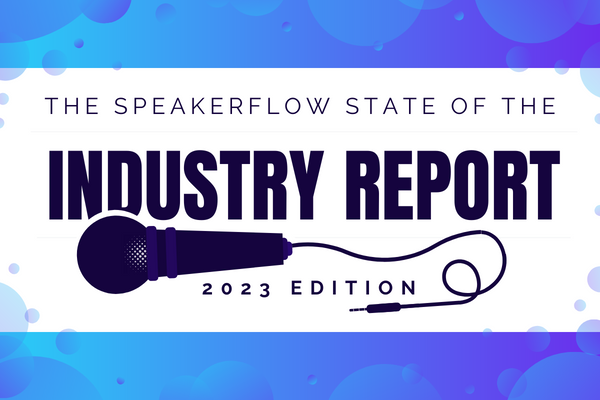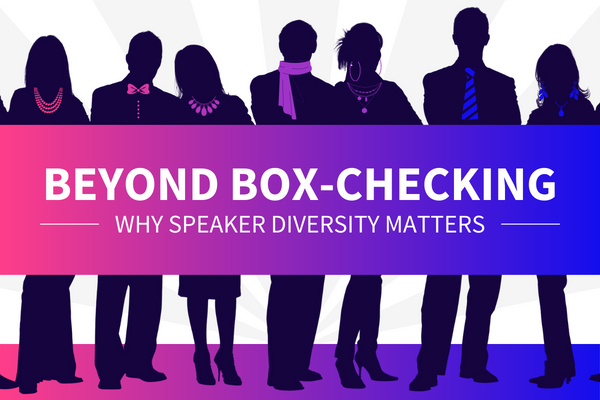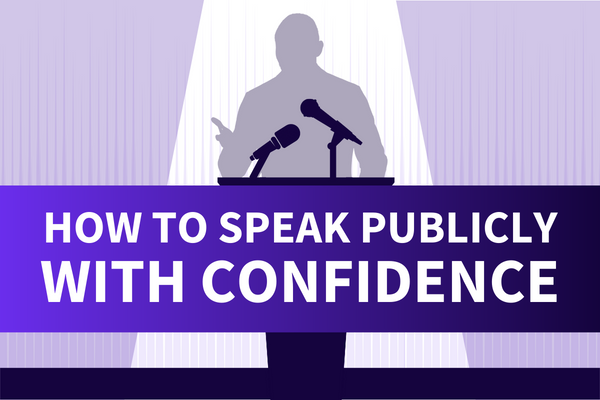Among entrepreneurs, one of the biggest challenges you’ll see is the constant evolution of the market. There’s new technology, new automations, and new consumer demands surfacing every day, all of which demand improved strategy from business owners. In the speaking industry, specifically, all of these changes can be incredibly fast-paced and overwhelming. This can leave many professional speakers – new and experienced – at a loss, asking “How do I market myself as a speaker?”
Simply put, speaking business marketing entails two channels. The first is inbound marketing, which involves creating content for your ideal audience, attracting them to you and your brand. These include blogs, videos, podcasts, and other forms of content. Conversely, the second channel, outbound marketing, involves reaching out to customers directly, usually through traditional marketing methods like cold calls and paid advertisements.
In order to successfully grow your speaking business, it’s important to devote time and resources to both of these strategies. It’s also vital that you keep tabs on industry trends and your competitors. That way, you can stay ahead of the curve and answer the question, “How do I market myself as a speaker?” with conviction.
- First, define your ideal audience by building buyer personas.
- Second, research notable speakers in your niche to learn from them.
- Third, determine where your audience – and potential clients – are most active.
- Fourth, tailor your digital presence to suit your audience and the platforms they’re using.
- Fifth, create, engage with, and contribute to content in your niche.
- Finally, never stop iterating on your marketing process.
First, define your ideal audience by building buyer personas.
Step #1 of speaker marketing is defining your ideal audience. As with any brand, your goal as a speaker is to share your message as widely as possible along with any products or services that help put that message into practice. However, if you’re marketing to the wrong people, not only will those products and services fail to sell. You’ll also wind up with a bunch of confused people asking, “What are you talking about? This doesn’t apply to me.” Plus, especially if you’re a solopreneur, time is money! You can’t afford to be spending it where you won’t see a return on your investment!

To avoid this, ask yourself first, “What is the purpose of my speaking business?” and “What message am I most passionate about sharing with the world?” Then, ask “Which industries or groups of people need to hear this the most?” Essentially, the people that fall into this category are your ideal audience.
That said, although your audiences will fall into broad categories, it’s also vital to pay mind to their individual needs and expectations. To do this, divide your ideal audience into buyer personas. If you haven’t heard of a buyer persona before, in basic terms, it’s a snapshot of one group of clients or, as HubSpot describes it, “a semi-fictional representation of your ideal customer based on market research and real data about your existing customers.”
Looking at your business, break your ideal audience into a handful of buyer personas (we usually recommend three to five). These personas will help you further refine your marketing efforts, so you can ensure you’re targeting people that are a good fit for your brand. Below is a checklist of what your buyer personas should include.
Buyer Persona Checklist:
- Name: A description of the persona (example: C-Suite Leader, Operations Manager)
- Age: A range based on past clients, may not always be applicable
- Industry: The economic category in which the persona operates
- Professional Background: Their title and role within their industry as a whole and within the organization they represent (the one hiring you)
- Level of Experience: Their depth of maturity and knowledge in their field
- Goals/Aspirations: Their professional and/or personal objectives (the things they would hire you to help them achieve)
- Challenges: Their professional and/or personal obstacles (the things they would hire you to help them overcome)
- Company Size/Budget: Their economic standing; their capability for hiring outside speakers or consultants like yourself (example: Fortune 500, startup)
- Information Channels: The platforms from which they find information and make purchase decisions
If you’re struggling to write buyer personas for your speaking business, HubSpot’s persona writing guide is another amazing source of inspiration. I also recommend checking out their list of questions to ask when outlining your personas. If you’ve spoken for a wide range of industries, especially, these can help you narrow your focus.
Second, research notable speakers in your niche to learn from them.
The second step to answering, “How do I market myself as a speaker?” is competitor research. Within speaking circles, you may have heard the argument that there is no real competition within the events industry, that every speaker is unique. But, while this is true to some extent, it’s also true that there are plenty of speakers addressing the same topics as issues as you are.
For example, one of the most well-known speakers of the last ten years is Kindra Hall. Although Hall’s focus is storytelling, her primary area of expertise is sales. In this way, her approach is unique – sure. But she’s also “competing” with other sales-focused speakers like Sam Richter, Mark Hunter, and Meridith Elliott Powell.
Likewise, regardless of your speaking topic, there’s almost certainly a long list of other speakers that advocate for the same thing. In marketing your speaking business, your job is to find those speakers, examine their strengths and weaknesses, and take note. In short, as American newspaper columnist George Matthew Adams once said, “There is a tendency among some businesses to criticize and belittle their competitors. This is a bad procedure. Praise them. Learn from them… You can’t destroy good ideas. Take advantage of them.”
To help you hit the ground running, we’ve broken down the following three examples from successful speakers in our network. Though you’ll still need to look for examples in your focus industry(ies), these will give you an idea of the caliber of business that qualifies as “exemplary.”
First Speaker Example: Shola Richards
With almost a decade of speaking experience, our first example is Shola Richards. An advocate for workplace connection and communication, Richard’s primary goal is to facilitate organizational change. In his words, “I help organizations build compassion, competence, and accountability in the workplace. As a result, sustainable and joyful peak productivity, engagement, and satisfaction become the new norm.” In sharing this message, Richards offers not only speaking and consulting but also continuous free content, allowing him to serve organizations or people that may not be able to afford his services.

Below are a few things you can learn from Richards as you market your speaking business.
- Consistent Personal Branding: Your brand colors, fonts, and styles should be uniform across all elements of your speaking business. This includes your website, speaking materials, and social media, to name a few.
- Eye-Catching Website Design: Strive for a website that makes you memorable. Nowadays, it’s vital to have a website in order to sell. But, having a distinctive, beautiful website can make your sales effortless. Plus, it’ll showcase your professionalism.
- Steady Content Creation: To show event organizers you’re worth hiring, you have to first show you know your sh*t and that you care. Creating consistent free content accomplishes both.
Second Speaker Example: Simon T. Bailey
Our second example is one of the most famous speakers in the United States, Simon T. Bailey. As a motivational speaker, Bailey is known for his compelling storytelling and public speaking style. He’s also known for his concentration on a central theme or vision, such as his current word “spark.” To hear him tell it, “My purpose is to help you find your purpose. With three decades of corporate training experience, I ignite transformation in organizations, systems, schools, and nations by inspiring the people within.”

Below is a list of additional tips and tricks to learn from Bailey and implement in your own marketing strategy.
- Consistent Messaging: Like Bailey’s “spark,” your message should be able to be distilled into a single phrase, if not a single word. If this isn’t possible, you may be focusing on too much at once or overcomplicating your message.
- Personal Authenticity: Throughout your personal brand, be yourself! From colors to marketing language, make sure your brand feels like you. It’ll make it immeasurably easier to sell your products and services if people can tell you’re being genuine.
- Up-To-Date Branding: Make time to update your brand regularly. At the very least, you should “refresh” your brand style every five years and do a complete overhaul every ten years. Otherwise, you run the risk of looking outdated.
Third Speaker Example: Jeannie Walters
The third and last of our examples is speaker and customer experience expert Jeannie Walters. The CEO of Experience Investigators, Walters is another example of sales-focused speaking. She’s also a perfect example of building your focus into a broad strategy, as she and her team don’t simply focus on sales strategy but also “help you map out your entire customer journey, identify where the gaps are, and train your staff and leaders to build deeper loyalty with every single small interaction.” In her own words, “My mission is to help you figure out where you’re losing customers and create an experience that your customers can’t help but rave about.”

Below are a handful of ways to further act on Walter’s insights in your marketing efforts.
- Diverse Sales Offerings: Not everyone will be able to afford your speaking fees, or they may want to work with you long-term. Account for these differing needs by offering various ways for people to work with you.
- Clear Language: Be explicit about how people can work with you, what problems you help clients solve, and how you do so. In every aspect of your sales and marketing efforts, being upfront about everything (products, services, fees, you name it) is always best practice.
- Free Resources: Show your commitment to your focus industries – as well as your remarkable industry knowledge – through free content. Not only will it make you look good. It will also entice readers back to purchase your products or services if they’re not able to do so immediately.
Third, determine where your audience – and potential clients – are most active.
Moving on, step #3 of learning “How do I market myself as a speaker?” is simple: track down your ideal audience. In each of the previous stages, we touched on how you can market to potential clients before and after the sale. However, before you can do this, you have to identify where your existing and potential clients are most likely to come across your brand.
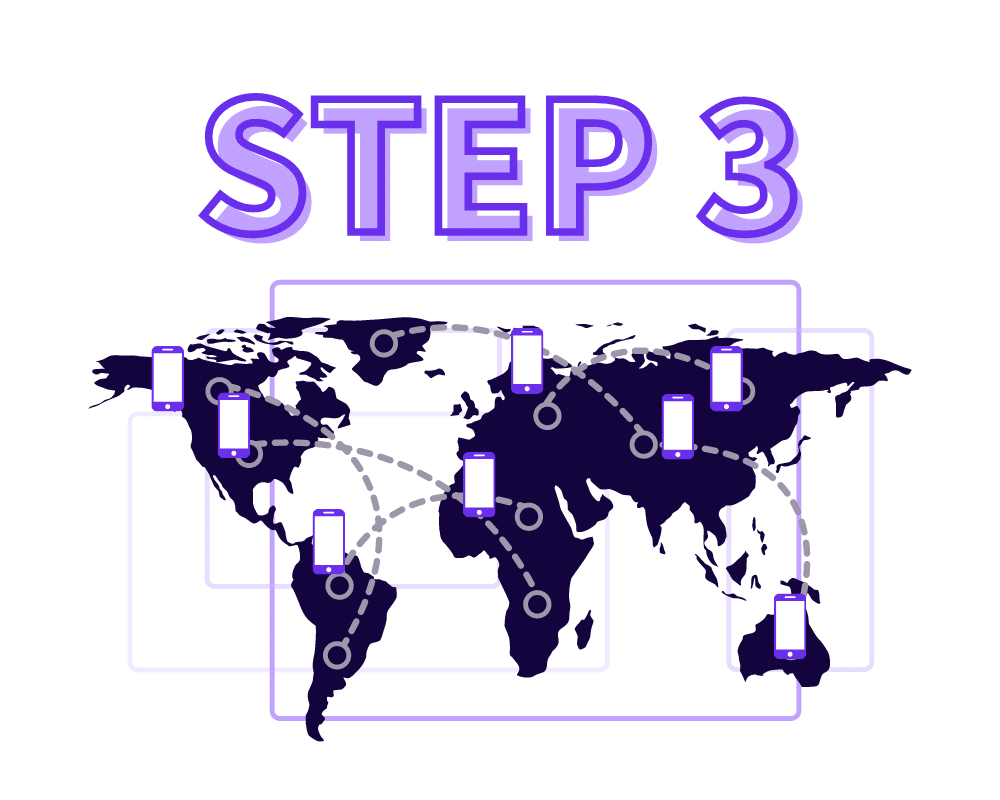
For example, if you’re marketing to small businesses, there are a few places to connect with your clientele. There are the usual channels, like LinkedIn or Facebook, where you can interact virtually at your convenience. But, you might also consider networking at community events, where you can get in front of business owners organically and demonstrate your skills without being pushy. They’re hoping to boost their own sales from within the community, after all. If your goal is the same, it’s only fair that you meet them halfway, where they’re already engaged and looking for opportunities.
In the same way, regardless of who you’re marketing to, you’ll always see more success from your efforts if you prioritize convenience. If you’re sharing a blog, make it convenient for your readers – and potential customers – to access it. If you’re offering a sale on a product or service, post sale notices where your ideal customers can conveniently find it and click “Buy Now.” The easier it is for someone to engage with your brand (and the more engaging it is when they do), the more likely they are to engage repeatedly or recommend you to others in their network.
Fourth, tailor your digital presence to suit your audience and the platforms they’re using.
The fourth step to answering, “How do I market myself as a speaker?” is fine-tuning your digital presence. Like your content, your digital presence should clearly suit the audience to which you’re marketing. This includes the colors, fonts, design elements, and language of your brand and internet profiles. Basically, if it’s a public component of your speaking business, it’s crucial that you consider the message it sends to your audience. No detail is too small!
In building these components of your digital presence, your aim also has two other elements, namely authenticity and consistency. Like in the speaker examples mentioned above, this means being yourself no matter where you’re interacting with potential customers.
To accomplish this, there are three broad categories of your digital presence to refine as soon as possible. Below, we’ll cover each of these items as well as some resources to help you begin.
Personal Branding
When growing a speaking business, your personal branding is essentially all of the visual elements that make you distinctive. From the colors you choose to the general style of your branded materials, your brand should convey a sense of professionalism as well as your personality.
The SpeakerFlow brand, for instance, uses bright colors, organic shapes, and clean-cut fonts, alluding to our passion for modernity and informality. Nevertheless, in our marketing language and in the layout of our brand, it’s also clear that we’re professionals. Sure, we’re less uptight than you might expect from consultants or tech experts. But we’re still dedicated to getting the job done and sharing valuable information and insights with our clients.
Your own brand should likewise convey a similar range of messages about you, your business, and what you stand for. For more information about how you can do this – through colors, fonts, and additional design elements – check out the following recommended resources.
- “How To Choose The Right Colors For Your Brand” from Canva
- “Everything You Need To Choose Your Brand’s Color Palette” from 99Designs
- “Build Your Brand: How To Choose The Right FontS” from Canva
- “How to create a brand style guide” from 99Designs
- “Personal Branding: How to Go from Zero to Hero in No Time” from Neil Patel
Building Your Website
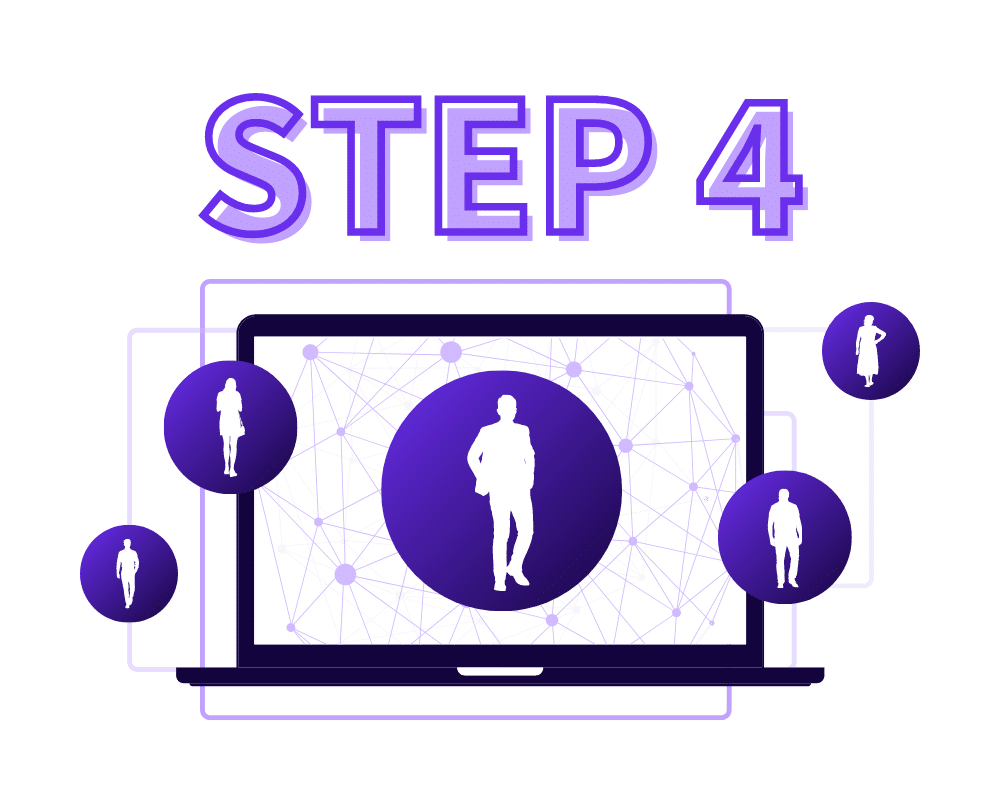
Perhaps the most obvious part of your digital presence is your website. Although speaker websites can vary widely, the best speaker websites not only communicate who you are and what you sell. They also act as a salesperson on your behalf, expressing the value of your products and services and providing proof of that value through testimonials.
Because of this potential – and because it’s the central hub of your business online – don’t skimp on the time and energy needed to maximize your website. If you’re unsure where to begin, the following strategies are a solid starting point.
Basic Website Checklist
- SEO-optimize your pages. It takes extra time to plan the text for each page, but it makes them easier to find on Google. Learn more about SEO for Google in their beginner’s guide.
- Include photos of you in action. It’ll make you look like a pro and help event organizers picture you on their stage.
- Include mockups of your products. It’ll make your products look polished, and add visual interest. Plus, tools like PlaceIt make it simple, so you can create a wide variety of mockups in minutes.
- Provide resources for event organizers. This includes your bio, photos, stage introduction – anything that makes it more convenient for upcoming clients to prepare (and shows potential clients how awesome you are to work with).
- Have a clear, consistent call to action. You want any interested site visitors to know how to reach you and feel compelled to do so.
For more information about building a speaker website, see our complete list of examples (and what you can learn from each one) in our previous blog.
Social Media
The last major component of your digital presence is your social one. Compared to building a website, expanding your social media presence can be much more informal. For one thing, you don’t necessarily have to be professional at all times, allowing you to share more of what you’re doing outside of work or be more candid about your daily life. For another, a wide variety of things are suitable for social media posts. A few examples are professional events, personal accomplishments, announcements about products or services, or even simple updates in your personal life.
In short, because of social media’s informality and because you’re managing a personal brand, your social marketing can be much more… well, social! There are still techniques that can boost your following, of course. But, overall, these strategies should tie into your individuality and your genuine approach to socializing with clients or audience members. Below are a few guides for such strategies, to help you begin.
- “How to Create a Social Media Branding Strategy From Scratch” from Neil Patel
- “10 Steps to Building Your Personal Brand on Social Media” from the Digital Marketing Institute
- “9 Ways to Use Social Media to Build Your Personal Brand” from Forbes
Fifth, create, engage with, and contribute to content in your niche.
Step #5 of “How do I market myself as a speaker?” is perhaps the most time consuming. However, it’s also one of the most rewarding aspects of the marketing process. I’m talking about contributing to the content produced in your focus industry(ies).
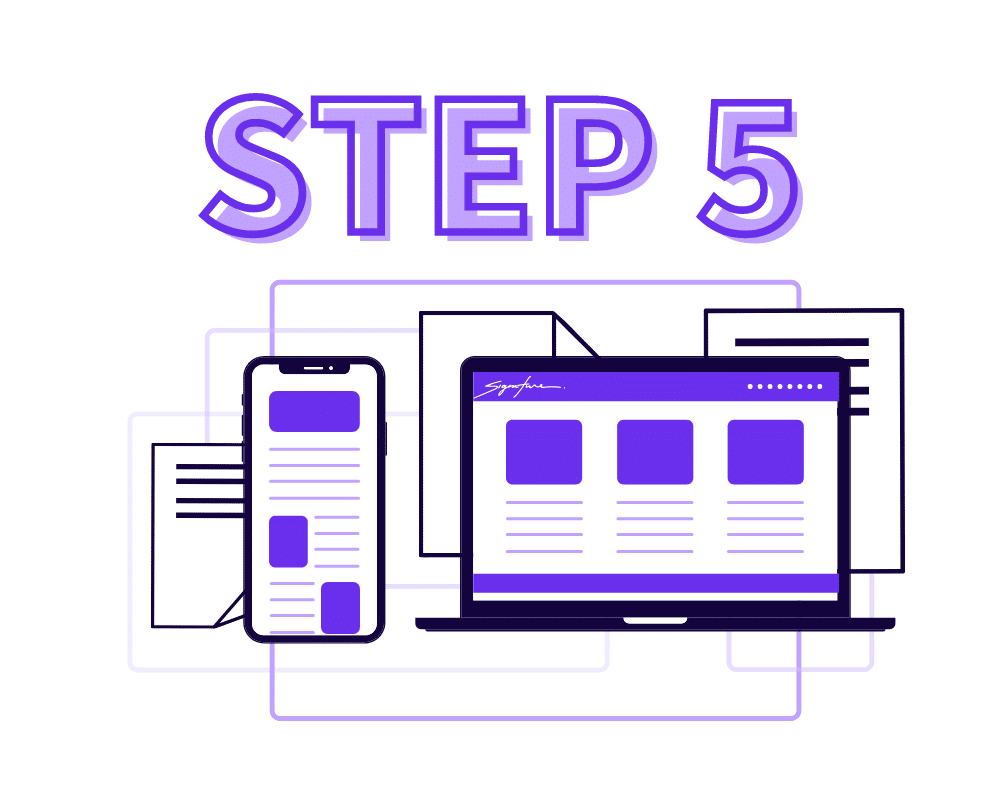
In recent years, as you’ve probably noticed, the sheer variety of content has exploded across every industry. There are blogs, podcasts, YouTube videos, social media videos, LinkedIn articles – the list is enormous. For many speakers, this can make it difficult to prioritize where to share content.
Luckily, the answer to the question, “Where should I create content?” is simple: create content where your audience is active. Back in step #3, you identified where people that fit your buyer personas are consuming content. In this step, you use that information to contribute to that content, marketing you as an industry expert and bringing readers into the top of your sales funnel.
In addition to creating content, it’s also important to redistribute your content across a variety of platforms. This process, also known as multichannel marketing, allows you to broaden your audience for a single piece of content. It also allows you to cater to people with different learning styles. For example, if someone’s an auditory learner, they may not be interested in a blog, but, if you have a video on the same topic linked in the blog, you may still retain their attention.
Once again, it’s all about making it convenient for your audience to engage with your content. That way, they stick around, see how amazing you are, and eventually purchase your products or services. Plus, if you engage with content from other leaders in your industry, you’ll appear approachable on top of looking like an expert. Win, win!
Finally, never stop iterating on your marketing process.
Last but not least, learning how to market yourself as a speaker is ultimately about iteration. For each of the steps we’ve covered so far, there are inevitably going to be components you miss. Maybe you overlook an industry trend and have to play catch-up late in the year. Maybe you misjudge your audience’s location and end up producing content in a vacuum for a while before course correcting.

Either way, as you market your speaking business, remember the importance of consistent improvement. Even when you make mistakes – because we all do once and a while – just focus on moving forward. If you continue listening to others, testing different strategies, and learning from your mistakes, I guarantee your marketing efforts will pay off in the long run.
Hopefully, by this point, the question “How do I market myself as a speaker?” is considerably less daunting than it’s been previously. To continue learning about speaker marketing, check out our ultimate marketing guide.
Additionally, for technology to support your marketing efforts, check out our operating system! With the support of the SpeakerFlow team, you’ll get more than a dozen apps designed to help you manage your business with ease. Book a demo to learn more and get started today. 👍


